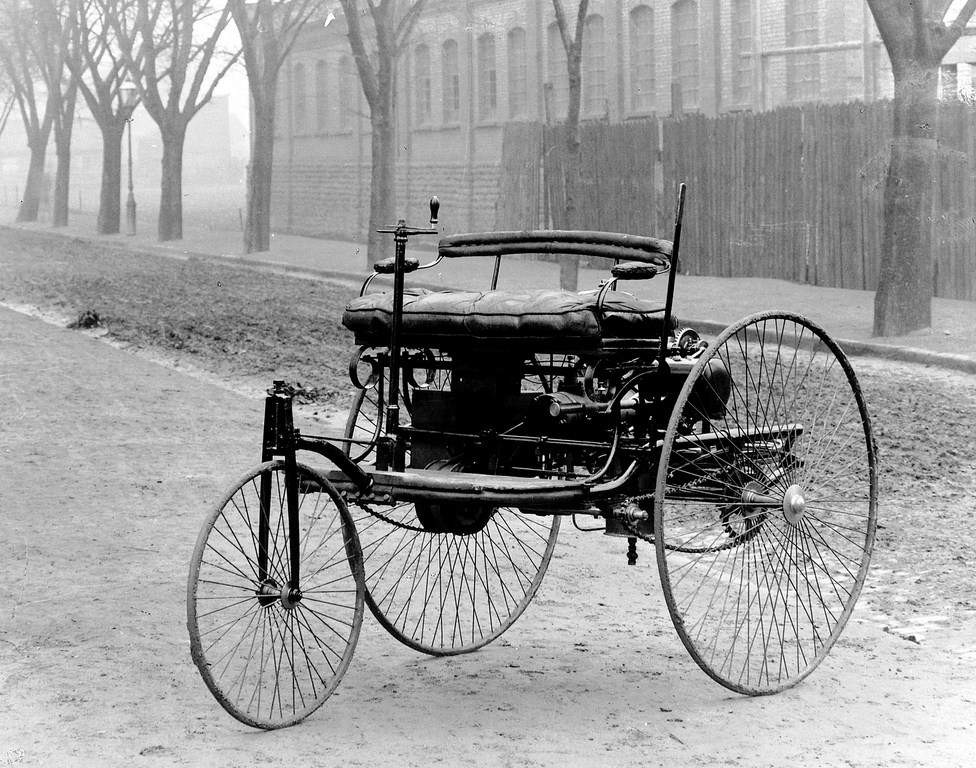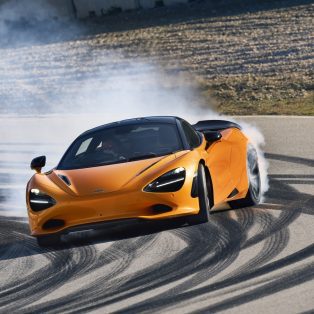1886 Benz Patent Motor Car
With the stationary two-stroke gas engine he had developed in 1879/80, Karl Benz had earned so much money that from 1883, he was able to concentrate more intensively on realizing his dream: a motorized road-going vehicle. Right from the start, he had been thinking in terms of an engine being fully integrated in a chassis and quite consciously discarded the idea of the sort of motorized carriage Gottlieb Daimler built at the same time. Daimler had the vision of driving every conceivable vehicle and appliance with his high-speed engine.
The vehicle rattling along Mannheim’s Ringstrasse on July 3, 1886 was the dream of an inventor, designer and passionate visionary come true: the Benz Patent Motor Car Number 1, the first proper automobile.
The engine
The heart of the vehicle was a single-cylinder four-stroke engine with a displacement of 0.954 liters – and it already had some of the major features that still rank among the basic elements of combustion engines today: a crankshaft with counterweights, electrical ignition and water cooling. According to Benz’ measurements, it developed two-thirds of a horsepower at 250 revolutions per minute. (Measurements at Stuttgart Technical University at a later stage recorded as much as 0.9 hp at 400 rpm.) Benz was completely satisfied with the 250 revolutions of his first – this speed was, after all, twice as high as that of his two-stroke gas engines.
Other features worth mentioning in conjunction with the engine included its weight which, at around 220 lbs (100 kgs), was very low by the standards of the time, as well as the cylinder with an open crankcase, an intake slide valve controlled via an eccentric rod, an exhaust poppet valve, operated via camshaft, rocker arm and push rod, and lubrication by means of drip oilers. Benz designed a flywheel that was to be fitted horizontally in the chassis since he feared that the gyroscopic effect of a vertically mounted flywheel would adversely affect the vehicle’s steerability and roadholding in tight corners.
For mixture preparation, Benz developed a surface carburetor which doubled as a reservoir for 1.5 liters of gasoline. The precise composition of the fuel/air mixture was adjusted by a sleeve-type slide control that covered the bores in the additional intake duct to a greater or lesser extent, thereby controlling power output. This slide control was fitted within easy reach underneath the driver’s seat.
Benz had several goes at the ignition until he came up with a solution that was matched to the low output of contemporary batteries. He used a Ruhmkorff induction coil to transform the electricity to a higher voltage. The spark plug was his own design, too. Investigations at a later stage revealed that the material used for the spark plugs’ electrodes was largely identical with that of commercially available spark plugs in the 1930s.
Cooling the combustion engine posed a particular problem because unlike a stationary engine, a vehicle engine cannot simply be connected to a coolant pipe. Benz opted for a simple evaporator which proved to be quite effective and adequate for the low output levels reached at the time. The engine was – and still is – started by courageous and vigorous turning of the flywheel. The fact that the gasoline filling in the carburetor did not permit longer distances to be covered, did – and does – not bother anyone driving the Benz Patent Motor Car. The ingenious propulsion system of this vehicle consumed as much as ten liters of gasoline – regarded as dangerous at the time – on 100 kilometers.
Chassis and bodywork
The frame was made of bent and welded steel tubing. Since the car was to have rear-wheel drive, i.e. to be pushed from behind, Karl Benz was faced with the problem of steering which had to differ from that of a pulled vehicle. Hence, the fifth-wheel steering customary on carriages had to be dispensed with – which is why Benz rather spontaneously decided in favor of a three-wheeler. The front wheel was suspended in an unsprung fork and steered by a toothed rack that was connected to a crank. (It was not before 1893 that Benz invented his double-pivot steering, one of the most important milestones in automotive design.) Benz also manufactured the wire spoke wheels with solid rubber tires himself – only the rims were outsourced. As customary in vehicle construction at the time, the front wheel was running in a ball bearing, the rear wheels in tinplate bushings.
The vehicle was driven with one chain each on the left and right-hand sides, running from the countershaft to the rear wheels which in turn were attached to the frame by means of a rigid axle and fully elliptic springs. The world’s first automobile did not yet feature a transmission with two or more speeds, nor did it have a reverse gear. Instead, a single speed was made available on the countershaft in the form of a fixed drive disc with integrated differential; next to it an idle disc was fitted. Thanks to the idle disc, the flat belt between engine and countershaft was capable of doubling as a clutch. For starting off, the flat belt was simply moved from the idle to the fixed disc. Road speed was adjusted by means of the sleeve-type sliding control under the driver’s seat. The coolant reservoir was mounted on top of the engine. The vehicle was decelerated by means of a manually operated lever acting on the countershaft belt pulley – there was no foot-operated brake. The bench seat was mounted on elegantly curved springs directly on the frame, ahead of the engine, and covered with perfectly finished and stitched leather, as befitting a thoroughbred roadster. Passengers were supported by low railings with leather upholstery at the back and sides.
German patent no. 37435
For reasons of secrecy, the first trials were staged in the factory yard in 1885 – and repeatedly ended in the factory wall. The first outing on normal roads – at night – lasted only a few minutes: the car broke down after just one hundred meters. But then, the distances covered became longer slowly but steadily. In retrospect, Benz wrote: ”I may well have reached a speed of 16 kilometers per hour with the car. Every trial strengthened my confidence, but on every outing, I also became familiar with new hitches of the engine. On the other hand, every journey provided me with ideas for improvement so that I was able to apply for a patent for the car in January 1886 …”
Karl Benz applied for a patent for his motorized vehicle on January 29, 1886. Patent no. 37435 became the birth certificate of the automobile. On March 25, 1886, a patent was applied for in France.
The patent specification was entitled ”Vehicle propelled by a gas engine” and its first paragraph read as follows: ”The construction concerned aims at operating predominantly lighter vehicles and smaller ships, such as are used for carrying between one and four persons. … Power is generated by a small gas engine, no matter what design. The engine is fed with gas that is vaporized from ligroin or other suitable substances by means of an apparatus carried on the vehicle. The engine’s cylinder is kept at a constant temperature through the evaporation of water.”
German patent no. 37435
In the early morning of a day in August 1888, Karl Benz’ committed and courageous wife Bertha, accompanied by their sons Eugen (15) and Richard (14), set out on the first long-distance trip in automotive history, without her husband knowing. Her intention was to make her husbands invention known beyond Mannheim and to demonstrate that his vehicle was not just suitable for traveling short distances. The journey took her from Mannheim via Weinheim, Heidelberg, Wiesloch and Durlach to Pforzheim, where Bertha had been born – and road connections between towns weren’t as straight at the time as they are today.
On her journey, Bertha cleaned a clogged carburetor with a hat pin and insulated a bare wire with her garter. On uphill gradients, her sons had to climb down and push the car time and again because engine power was not always sufficient. The car lacked a transmission or at least another gear. The heavily strained shoe brake had to be lined with new leather several times, and the supply of valuable ligroin had to be replenished at the chemist’s in Wiesloch. The world’s first woman at the wheel and her sons arrived in Pforzheim in the evening, covered with dust but safe and sound and with a wealth of newly gained experience. By traveling 180 kilometers from Mannheim to Pforzheim and back again, Bertha Benz had demonstrated the motor vehicles practicality to the whole world. With her daring and that of her sons – and the crucial stimuli her trip provided – the rise of Benz & Cie., Mannheim to become the world’s largest automotive producer at one stage wouldn’t have been conceivable.
Twenty years after its maiden journey – the maiden journey of the first holistically designed motor vehicle the Benz Patent Motor Car Number 1 was rediscovered in a distant corner of Benz’s automotive factory, scrupulously restored and, on the occasion of its 20th anniversary, donated to the Deutsches Museum (German Museum) in Munich.
In Detail
| engine | 4-Stroke Single Cylinder Engine w/Evaporation Cooling |
| position | Horizontally Installed |
| valvetrain | Pushrod Operated Sliding Intake Valve & Vertically Mounted Exhaust valve |
| displacement | 954 cc / 58.2 in³ |
| bore | 90 mm / 3.54 in |
| stroke | 150 mm / 5.91 in |
| power | 0.7 kw / .9 bhp @ 400 rpm |
| specific output | 0.94 bhp per litre |
| bhp/weight | 7.5 bhp per tonne |
| body / frame | Tubular Steel Frame |
| driven wheels | RWD w/Chain Drive |
| front tires | Solid Rubber Tires |
| rear tires | Solid Rubber Tires |
| f brake size | mm / in |
| r brake size | mm / in |
| steering | Toothed Rack & Crank |
| f suspension | Unsprung Steering Forjk |
| r suspension | Rigid Axle w/Elliptic Springs |
| curb weight | 120 kg / 265 lbs |
| wheelbase | 1450 mm / 57.1 in |
| rear track | 1190 mm / 46.9 in |
| length | 2700 mm / 106.3 in |
| width | 1400 mm / 55.1 in |
| height | 1450 mm / 57.1 in |
| transmission | 1-Speed |
| gear ratios | :1 |
| top speed | ~16 kph / 9.9 mph |














